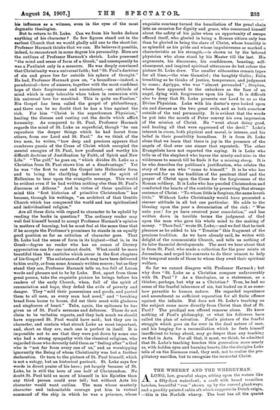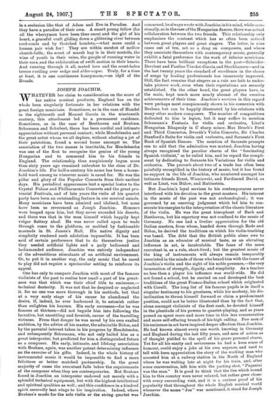THE WHERRY AND THE WHERRYMAN.
ALONG, low, graceful shape, sitting upon the waters like a fifty-foot waterfowl; a craft with broad vermilion hatches, beautiful " run " shown up by the curved plankways, and a gaudily painted cabin aft which suggests its Dutch origin, —this is the Norfolk wherry. The boat has all the quaint
picturesqueness of the Dutoh vessels without their ungainli- ness. But the greatest charm of the craft is the immense sail, huge yet dainty. The long-peaked sail is tarred and oiled till it possesses that rich Vandyke brown which con- trasts so effectively with the green reedbeds amongst which it glides. This long sweep of sail cuts darkly up into the atmosphere of the Broads, giving a bold effect which very few artists dare reproduce. Whether bellying out before the wind like some great dusky balloon, or hauled flat so that the fore- shortening sends the high peak pointing up from the gradual curve of canvas seen edgewise, the wherry's sail is always graceful. Beyond a forestay, the sturdy mast is unsupported by rigging, and it is a forty-foot fir-tree. Yet under a stress of wind the pressure of the thrusting sail bends it like a hunter's bow. A gaudy vane swings upon the gaily painted masthead, above the rings of gold and red and the white top. The ancient wherryman who sits on the tiller aft, with feet braced against the hatch-coamings as he manages the sheet. has a sure index to the direction of the breeze in the gilt vane, —the figure of Fame blowing a trumpet.
The wherry of to-day is the evolved product of three or four centuries. When the Flemings settled largely in the Eastern Counties during the latter half of the sixteenth century (certain doles are still given on stated days to their descendants), they, as a maritime people, saw the value of the sluggish rivers as a means of transport. Previous to Dutch iuflu- • ence, the local boats which were used for conveying cattle and merchandise resembled the flat reed-boats of the present day. These were built on a larger scale and fitted with plankways. This innovation was shortly followed by the addition of hatches and the brightly coloured, high Dutch cabin. Next, the early wherrymen stepped masts in their crafts and hoisted sail. Neither the mast nor sail was like those used now, for the mast was central and bore a square sail set on a yard. But even on the early wherries the canvas was hoisted with a winch in the bows, and possessed no stays or " burtons." The vanes favoured by wherrymen at the present time are of later date; the " Welsh Girl," the sailor holding a wire vane, and the figure of Fame are more modern ideas. Old Norfolk pictures show the "keels," as they were first called, to be of the style indicated. These " keels " were used mainly for timber-freights.
Formerly the Norfolk wherry had a square stern; now both stern and stem are pointed (this was not the case thirty years ago). The mast has gradually crept forward, and the great sail hoisted on wooden hoops round the mast and with a gaff has been evolved. It is, of course, an example of adaptation. No other craft is so suitable for freight-carrying on the narrow waterways, and at the same time so easily handled. The wherry's mast, ponderous as it appears, is easily lowered to permit of the vessel passing under the stone bridges which span the rivers. The mast is pivoted on a bolt about six feet from the butt, which is weighted with iron or lead until it almost balances the length of mast above the pivot. So finely • is the adjustment made that, by means of the two blocks on the forestay, a boy can raise it. A peculiar method of hoisting is adopted, for the sail is hoisted and peaked by a single rope wound on the winch at the foot of the mast. Wherries sail very fast, but the great feature is their power to hang on a wind ; they will sail closer than any other craft afloat. This is partly due to the flattening capabilities of the sail, but in a greater measure to the graceful lines of the long hull. Yet though a wherry will sail so close-hauled, she turns slowly by reason of her great length, and it is usual to push her head round with long poles known as " quanta." The inability to turn quickly necessitates the use of an immense rudder with a peculiarly curved tiller.
" Freighting," as wherrying is termed in the vernacular, is far from being a decaying business. Water-carriage compares favourably with rail-transport, and the winding rivers link together little Broadland centres which it would require a perfect network of lines to connect. The chief "freights" are grain, wood, and stone. A wherry laden with sawn deals cunningly stacked so as not to interfere with handling is a very common sight.
There are few more skilled occupations than wherrying, as the novice soon discovers. In " quanting " one has to plant the end of an eighteen-foot ash-pole at the bottom of the river, and, pressing the knob which terminates the butt firmly against the shoulder, to toil from stem to stern of the wherry as it moves under one's feet. If the quant be set too far from the plankways, there is a loss of power ; whereas if it be set too near the free-board, an inexpert wherryman is likely to be pulled overboard by a bending quant, or to break the imple- ment under the bull of the wherry. As an expert would say, " It want some sleight ' " ; and the same expert would also insist upon the novice " paiiyin' his futtin'." The wherry's huge sail can be reduced to about half-size by means of a double row of reef-ties : this is expedient, as an ordinary sail contains nearly a thousand square feet of canvas. In extremely light winds the wherryman enlarges his sail by lacing to the lower part a strip of canvas about three feet wide. This is known as the "bonnet," and when it is used the wherry-master will explain that " the ole lady her got her bonnet on."
The Norfolk wherryman, like the craft be sails so well, is a type in himself,—a picturesque and peculiar type. Not infrequently the wherries are sailed by a man and his wife.
Imagine a little old fellow with the wildest of grey beards, a slaty face puckered with age, and wearing a multitude of clothes, and you have a fair picture of the old-style wherry- man. He seems to have the lips of a salamander, for he is wont to smoke a ridiculously short clay pipe, its inverted bowl nestling affectionately in his flying beard. The wife is a merry creature with a smoke-begrimed face, for the little coal fire in the stuffy cabin smokes when the chimney on deck is removed to allow of the sail passing over it. With a coloured shawl over her head, the wherryman's mate is in the habit of sitting in the well by the tiller and surveying her tiny home.
The cabin is nothing more than a hutch, rather uncomfort- ably dirty, and flavoured with a bedroomy smell. Two benches on either side of the diminutive stove act as seats by day and as bedsteads by night.
One would gather from the names of the various "raiches " on the rivers that the wherryman has a natural turn for description. Among the best-known names are the "Duffer's," "Bowling Alley," " Horseshoe," and " No Man's Frind." In the last-mentioned reach, if the wind be fair, it will be foul in all the others, and vice-versa'. Hence the name. The little man with the wild beard is a small tyrant in his way, and his spouse is under complete control. When the craft is " beating," it is she who has dutifully to put the tiller over at the end of each board, whilst her lord shoves the wherry's head round with the quant. Then his brief command, " Aise ut!" which is equivalent to " About ship !" is snorted out at intervals as be skilfully drops the quant-point amongst the rond-stuff and prepares to thrust. There is no "starboard" or "port" in his instructions to the woman at the helm. He tells her to put the tiller to the "mustard-side" or to the "salt-side," for these condiments are kept on opposite sides of the cabin. Perhaps he refers to the "poker" or "tongs" side instead.
To obtain a commensurate idea of the nicety of handling expected of a wherryman, one needs to bear two of the cult discussing" freighting." Wherrymen's ethics are strange and startlingly naked in their primitiveness. This is what one hears when wherrymen talk. " You go on ! You ain't a wherryman Waal, I reckon you ain't. You salty you was brought up on a wherry. No, you wasn't : you've bin to schule. A wherryman, what I call a wherryman, was born on a wherry, and lived on it all his life Now, ole Gay, he was a wherryman if you like. He was on a wherry from the time his mother had him to the time he died. And he could handle a wherry, anyhow Ef he had a fair wind, his ole lady'd sail the wherry, and he'd be drunk in the cabin. She'd git some one to help her at the bridges with h'istin' and lowerin', and she didn't want a sight of help arter that."
This typical delivery, quoted verbatim from a wherryman of the older stamp, is illustrative of two things. That to be a wherryman a man can be nothing else; he can be neither a fisherman, nor a marshman, nor a smelter, but simply and solely a wherryman. Again, the remarks illustrate the primi- tive attitude of the male towards the female. The woman wants to get home to her baking, or perhaps to her children, who now are made to attend school. The wherryman appreciates this, and takes advantage of the fact.
But when a wherrying couple are first married no one could imagine a more ideal life than that on a wherry. Primitive if you will, primordial even, but the man and the woman have each the other. They give one another mutual aid ; they live
in a seclusion like that of. Adam and Eve in Paradise. And they have a paradise of their own. A smart young fellow (for all the wherrymen have been thus once) and the girl of his heart, a graceful craft gliding down a glittering river between reed-ronds and by thatched hamlets,—what more could a human pair wish for ! They are within earshot of mellow church-bells; the scent of marsh hay is in their nostrils, the wine of youth in their veins, the gurgle of running water in their ears, and the exhilaration of swift motion in their hearts. And running through it all, mated love and the scent-laden breeze rustling over sedge and alder-copse. Truly, for a time at least, it is one continuous honeymoon,—an idyll of the Broads.




































 Previous page
Previous page